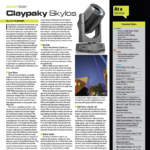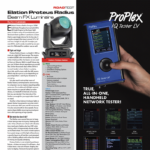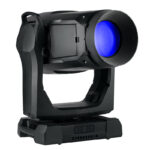Since 1983, TMB has supplied some of our industry’s hottest products — ProPlex Data Distribution equipment and cabling, ProPower power distros, and others. A year and a half ago, they introduced their Solaris LED line of fixtures, including the new Solaris LED Linear battens, which come in four different configurations for not only direct viewing, but also as a cyclorama wash role or as a high-powered performer wash.
The version TMB sent me was the ten-by-four version, featuring 40 RGBW arrays and a lot of output power. It is intended for use primarily in a cyclorama or wall-washing applications.
Physically, the unit’s exterior is constructed from stamped, powder-coated aluminum, giving the unit a very sturdy and solid feel to it. Included are floor mount brackets that also have holes for mounting the rigging hardware of your choice, and the construction is quite heavy-duty. Other rigging accessories are available. On the version I tested, the 40 RGBW LEDs form two rows along the face of the fixture. They are divided into 10 four-element pixels — each “pixel” being a square of four. The fixture has settings that allow the user to control the number of pixels (separately controlled sections), and the options include either one, two, five or ten sections.
Light Source
The 10-watt Cree sources are mounted on small square packages with a small, clear, bubble-like lens over the four dies to bring the native beam angle down to something more usable as it meets up with the TIR lenses. These are then mounted on a removable circuit board in groups of four, which sit on a large chunk of aluminum running down the middle of the light, which acts as a heatsink and mount for the internal circuit boards. There is a large thermostatically controlled fan that is on by default, though it can be configured to only run when needed. Total fixture wattage while running at full is 400 watts, which generates a lot of heat, enough to require gloves when handling the fixture.
Output
The dimming curve was incredibly smooth, matching an ideal square law curve almost exactly, though you can select a linear curve in the menu system, a setting TMB refers to as “gamma.” There was no visible stepping anywhere in the range except for the last few clicks before blackout, and those were very slight. TMB provides two speed settings for interpolating and smoothing the DMX data during fades: a mode called “SmartFade,” which smooths out slower crossfades, but still allows instant changes for cues that need to be snappy. Alternatively, the user can set a fixed fade time, so that any change in the DMX values will fade over the set time, between 0 and 2.5 seconds. Both these modes eliminated any visible stepping on the low end during fades. The PWM frequency is 1200Hz, which should be fast enough to avoid flicker problems with cameras. An option in the menu allows the user to select between 50 and 60hz line frequencies.
I measured the output immediately upon power-up with all emitters at full, and again after reaching thermal equilibrium 20 minutes later, and output had dropped to about 75 percent of initial levels and was stable from then on.
Optics
Sitting above the dies mounted in removable metal frames are the TIR (Total Internal Reflection) lenses — clear plastic cones with an indent in one end that fits over the primary optic on the dies and controls the beam angle and helps with fringing and homogenization. These do a reasonable job, and I saw only minor multicolored shadows at normal throw distances. There are a number of lens options available, including 16º, 22º, 36º, and 47º, which can all be swapped easily. I tested the 16º and 22º version; the different angles help with the wash mix. Internally, the sources are rotated relative to each other to further help with homogenization.
This unit is intended to be used as a cyc light, and as such, there is an asymmetric distribution of the two different types of lenses — the side with more of the cross-hatched lenses should be closer to the surface to be washed to help prevent the “light column” look that can occur without diffusion. Additionally, there are small retaining clips on the fixture for a strip of plastic frost diffusion to further enhance the output mix. These strips work very well, diffusing and smoothing the output for cyclorama or wall-washing applications where the fixture needs to be right up against the surface to be lit, and are available in sets of one or two.
Colors
The colors chosen are of the standard variety, blue being the deep “royal blue” shade, (460 nm) which is something to keep in mind when mixing the Solaris LED batten with other fixtures in your rig that might use blue emitters (476 nm). With full output (all emitters at 100 percent), the output had a slightly pinkish hue — quite common with RGB systems, because the green emitters get overpowered by the red and blue. Mixed whites were very clean, from a 5600 Kelvin white down a pleasing incandescent glow. The addition of the white emitter helps a great deal in creating pastels and lighter shades, filling in the valleys left by the RGB emitters. Alone, it produces a very pure, bright white. On a side note, I don’t see too many straight RGB fixtures these days, and the increasing sophistication of our LED color systems are resulting in markedly better color rendering, which I am extremely happy to see. Measured output percentages of all the emitters individually added up to more than 100 percent, indicating that TMB is utilizing some load sharing among the LED elements.
Control
The batten includes several different control modes, including both RGB and RGBW control in 8 or 16-bit modes. There is also an option to use strobe channels with the fixture, which allows a variety of effects, including flashes, ramps, random strobes, lightning effects, and spikes. The strobe mode allows you to also use the fixture as a regular batten by setting a “Wash override” channel on the fixture, and allows full access to the pixel mapping features as well.
The strobe mode also includes an effect layering solution that TMB refers to as “Meltdown,” a feature they introduced with the wildly popular Solar LED Flare wash/strobe/blinder. With this mode active, you can apply strobe effects over not only an existing background color, but over the top of any color chases or effects that are running on the pixels. For instance, one could have a blue to red effect running across the pixels, and then have a yellow strobe randomly across the fixture. TMB says when using this feature they recommend patching the fixture in two parts, as a wash layer and a strobe layer, and in my opinion that’s probably the easiest way to program them.
Conclusions
The fixture includes Neutrik powerCON in and through for daisy-chaining fixtures together, and auto-ranges input voltages from 100-240VAC. DMX input is five-pin in and throughs, and all menu functions are accessed via a full-color menu on the rear of the fixture. The fan is the only moving part, and can be somewhat loud when running at full speed, something theatrical users should be aware of.
The Solaris LED range of fixtures — the Flare, the Mozart, and the new SoLED — have proven their utility on stages around the world, and the linear LED batten joins as an excellent solution for houses of worship, concerts, and theaters around the world.
At a Glance
Rugged, Yet Smooth
Featuring 40 10-watt Cree LEDs, the 10×4 Solaris LED linear batten fixture tested by PLSN was impressive for both its rugged, tour-ready build quality and smooth dimming curve. A strip of plastic frost diffusion can further diffuse and smooth the output for cyc washing applications, and users can also choose between RGB/RGBW control in 8 or 16-bit modes along with a variety of strobe effects and pixel-mapping applications.
Solaris LED Linear Battens
Pros: Quality construction, very bright, excellent dimmer curve
Cons: Fans are somewhat loud
Configuration Options
- RGBW 16×4 Batten
- RGBW 10×4 Batten
- RGBW 16×1 Half-Batten
- RGBW 3×4 Brick
Features
- In-lens color mixing.
- Optional lenses for multiple beam angles.
- Multiple control modes, including
- parametric modes with effects, whole
- fixture control, and independent
- pixel control.
- Flicker-free output with smooth 16-bit dimming.
- 16-bit DMX512 control
More Info tmb.com



